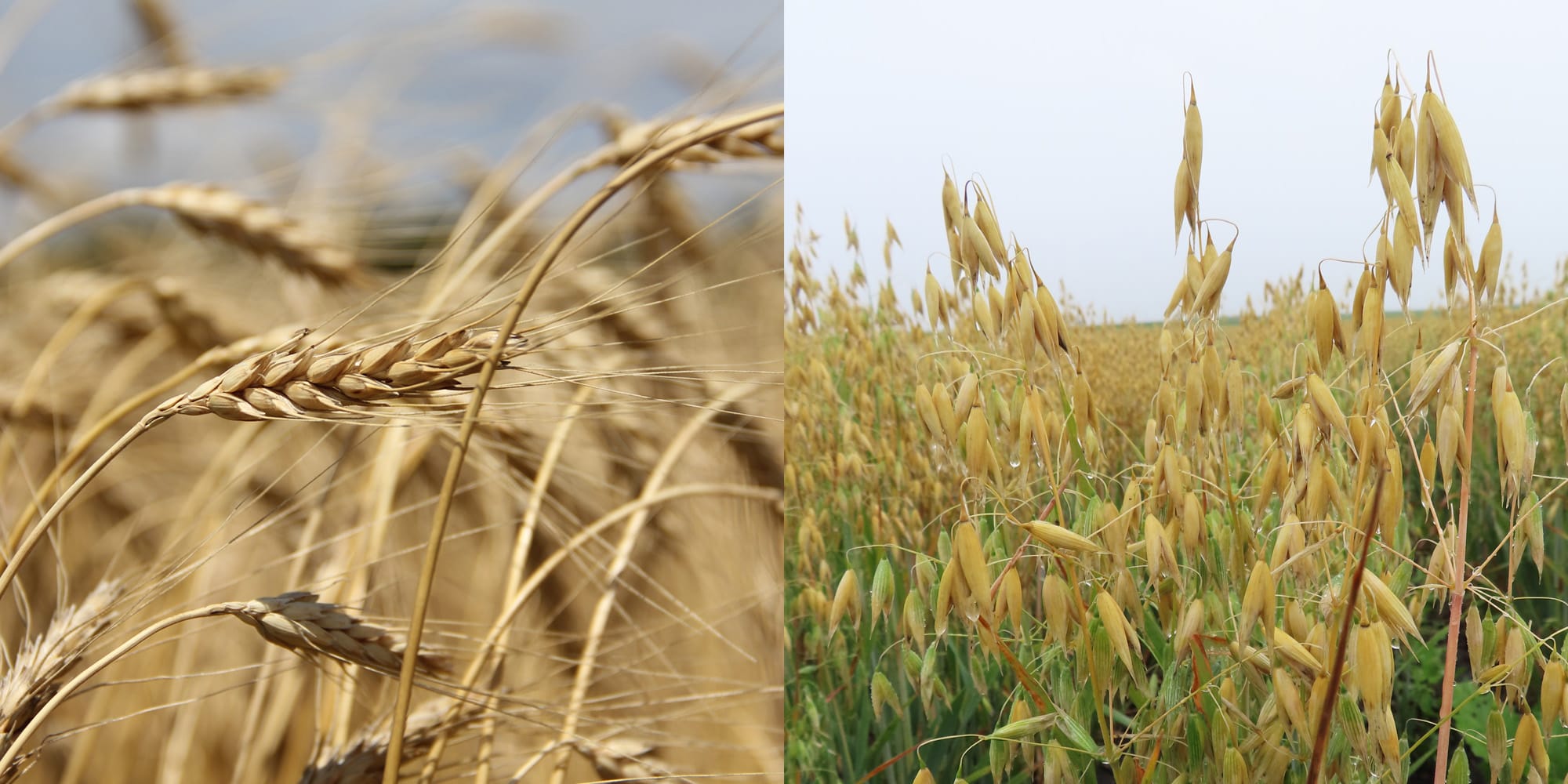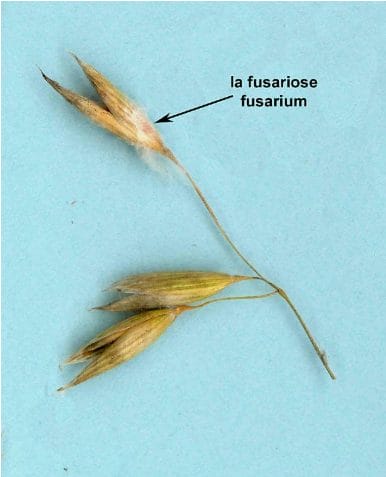When Conditions Are Right: Exploring Prevention and Management of Fusarium Head Blight in Oats
Spring and early summer of 2024 were unseasonably wet across much of the Midwest. As temperatures warmed, oat farmers kept a close eye and took action to limit crown rust, the disease that causes most yield losses each year.
Farmers weren’t prepared, however, for Fusarium head blight, an anomaly in oats, to also make a grand appearance. As grain was brought in for market testing, the presence of deoxynivalenol, also known as vomitoxin or DON, showed that FHB had taken its toll on the crop across southern Minnesota, northern Iowa and southwest Wisconsin.
“That shook everybody’s foundation of what you can and can’t do with oats,” says Jochum Wiersma, small grains specialist at University of Minnesota, who shared about disease management and prevention in oats during our April 2025 shared learning call.
Of the more common diseases found in oats, barley yellow dwarf virus, transmitted by aphids, and loose smut, a seed-borne disease, are both managed fairly well through variety selection. Crown rust is a perennial nemesis, as the alternate host, buckthorn, allows it to not only overwinter locally, but constantly create new virulent strains that render crown rust resistance varieties ineffective over time. Fungicides ward off yield losses in those instances when a variety no longer has effective genetic resistance. Meanwhile, public breeding programs continue to search and incorporate new sources of genetic crown rust resistance in their new oat varieties.
A Close Look at Fusarium Head Blight
“In my whole career, FHB has been front and center in spring wheat and barley. It’s been truly the only constant in those 30 years,” Jochum says, “but FHB in oats was considered more of a singularity.” This is primarily because an oat panicle is more open than that of wheat or barley. Leaf wetness periods of more than eight hours are important for FHB to thrive, but oats generally dry out before reaching that mark. However, the constant warm and humid weather experienced in June and July 2024 offered the perfect conditions for FHB to thrive in oats.

An oat panicle (right) receives much more air flow than a panicle of wheat (left), reducing the potential for Fusarium head blight.
The fungus that causes FHB is Fusarium graminearum. This fungus has a great number of hosts including many grasses such as small grains and corn. It causes stalk and ear rot in corn and FHB in all of the small grains. It survives and remains viable on the host’s crop residue, including corn stover, for more than a year. For this reason, it is key to avoid rotating to a small grain after corn. Even with that important precaution, in a corn-dominated landscape with a consistent presence of spores, weather conditions hold the greatest influence over infection rates in small grains.
When raw grain is intended for food-grade, DON levels need to be under 2 parts per million and the finished product must have levels under 1 part per million. In 2024, many farmers across the Midwest saw concentration levels above 2 parts per million and some even above 4 parts per million, caught unaware because oat kernels often appear normal externally even when DON is present.
“When the kernels are just starting to form right after fertilization, those early infections are by far the most impactful,” Jochum says. For wheat, such infections result in a high number of aborted kernels that don’t even reach the hopper, lowering the concentrations of DON in the harvested grain. However, that is not the case for oats. When one infected oat kernel can have a DON concentration as high as 200 parts per million, it doesn’t take many individual kernels to sour an entire sample.
How to Respond and Prepare
As oat tests began showing high levels of DON following harvest in 2024, Jochum wanted to see if cleaning could reduce concentrations. He used a tabletop aspirator and Clipper grain cleaner with sieves to clean 11 oat samples varying in DON concentration, test weight, germination rate and percentage of pink (infected with FHB) kernels.
After analyzing results, Jochum concludes, “We don’t see the very drastic changes in quality by simply getting rid of the smaller, lighter kernels.” This shows that prevention and management of FHB in oats should draw more from knowledge of FHB in barley than in wheat. Wheat can be easily cleaned to reduced concentrations, whereas barley cannot.

Fusarium graminearum may appear as a subtle salmon pink color on some oat heads but often hides inside the hull. Photo credit: K. Lynch (New Brunswick Department of Agriculture and Aquaculture)
Since cleaning is not an effective strategy for managing DON in oats, farmers must turn instead to preventative measures. To date, little research has been done to trial oat varieties for FHB resistance and the trait has not been a priority in breeding programs. Without this knowledge, risk assessment and subsequent fungicide application currently hold the key to preventing elevated infection levels of FHB. Weather assessments and web resources like Penn State University’s Fusarium Risk Tool can help a farmer decide whether to apply fungicide.
One challenge is that the optimal stage to spray for crown rust (Feekes 9 – flag leaf emergence) is about seven to ten days earlier than the optimal stage to spray for FHB (Feekes 10.5 – when head has fully emerged) as assumed based on understanding of FHB in barley. Crown rust can make a complete life cycle in that time. Jochum says, “We are in a conundrum because the underlying assumption is we only want to get out there once and not twice because that might become cost prohibitive.”
Furthermore, there are only two fungicides that are labeled to control FHB in oats – Miravis Ace and Sphaerex. This limits availability of fungicides that are known to be effective in controlling the disease. Fortunately, those two fungicides may also be used to prevent crown rust.
When applying fungicide, it is important to cover as much of the head as possible. Jochum urges farmers to use a forward and backward facing nozzle to establish coverage of the fungicide on all sides of the oat head. He also suggests reading through the “Ground Application of Fungicides for Fusarium Head Blight Management” publication from North Dakota State University Extension for recommendations on spray volume, pressure and nozzle types.

A nozzle that sprays in two directions is vital for covering an entire oat head when applying fungicide for FHB. Photo credit: Tom Wolf, Sprayers101
Future Research
Using fungicide to prevent FHB is not an option for organic farmers, who instead rely primarily on finding disease resistant varieties of small grains. Unfortunately, because FHB has not been common in oats, there is a dearth of knowledge of which oat varieties, if any, hold some resistance to the disease.
Fortunately, as of spring 2025, Jochum and Kevin P. Smith, a professor in small grains breeding and genetics at University of Minnesota, have received funding to research prevention and management strategies for FHB in oats. They will test current varieties for genetic resistance to FHB in inoculated nurseries and conduct fungicide trials to determine efficacious application methods. Jochum is hopeful that this work will offer insights into how to breed FHB-resistant oat varieties, alleviating a level of stress for oat farmers in the future.
Additional Resources
Concerned about the potential of disease in your oat crop? Check out these resources to be informed of when the disease could cause issues and how to effectively respond.
- North Dakota State University’s “Ground Application of Fungicides for Fusarium Head Blight Management”
- Penn State University’s Fusarium Risk Tool
- Iowa State University’s “Foliar Fungicide in Oat Production” (focus on crown rust and barley yellow dwarf virus)
- Practical Farmers of Iowa’s “Improving Resilience and Profitability Through Oat Breeding”
- 2025 Winter Webinar: “How Do Small Grains Grow and Develop? Harnessing this Knowledge to Improve Management”
- Agronomic Crops Network – “What is the Meaning of Feekes Growth Stages in Wheat?”
- Subscribe to FHB alerts from the U.S. Wheat & Barley Scab Initiative
Sign up for Small Grains News, PFI’s monthly email newsletter highlighting all things small grain-related, to receive updates on trial results, helpful resources and events.
